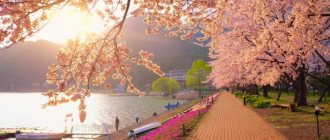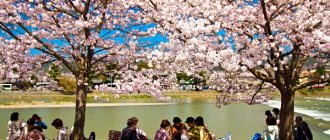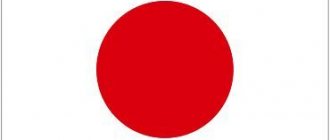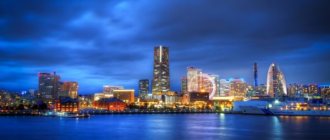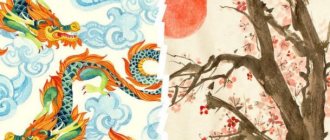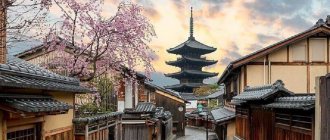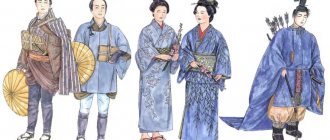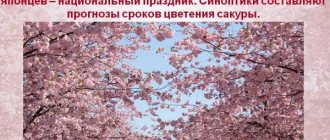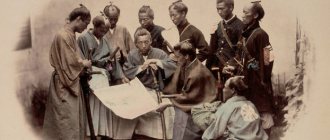Japan has long attracted the attention of businessmen, scientists, cultural figures, and tourists. This is facilitated by Japanese culture, which managed to develop original features, first being in the shadow of the great Chinese civilization, and then experiencing the colossal influence of European culture. In addition, tourists to Japan are also attracted by the unique natural landscapes, as well as the numerous technological achievements of the inhabitants of the Land of the Rising Sun.
Japan
Land of the Rising Sun
For the first time, state formations on the territory of modern Japan are mentioned in Chinese chronicles of the 3rd century; the principality of Yamatai was considered the strongest at that time. In the 6th century, during the correspondence of the Emperor of Japan with representatives of the Chinese Sui dynasty, the expression “Land of the Rising Sun” arose - this is how the Chinese called Japan because of its more eastern position in relation to China. The name stuck, and for more than 1,400 years the Japanese have been calling their country that way.
Currently, Japan is one of the most developed countries in the world. It can surprise any tourist with historical sights, various resorts, museums, amusement parks, national cuisine, and futuristic architecture. So it’s worth spending time and money on a trip to the Land of the Rising Sun from Russia and see for yourself how many wonderful places there are.
Land of the Rising Sun
Japan is the only empire in the modern world. The current Emperor Akihito is considered the 125th descendant of the first Emperor Jimmu, who reigned in the 4th century.
Where is
The country is located on a large archipelago of almost seven thousand islands, which is located in the Pacific Ocean, southeast of Vladivostok and approximately 7.5 thousand kilometers from Moscow. It is washed by the Sea of Okhotsk, Japan, East China, Philippine and Inland Japan, as well as the Pacific Ocean. In the north it is separated by straits from the Russian islands of Sakhalin and Kunashir.
Japan map
How to get there from Moscow
When wondering how much a trip will cost, you will probably come to the conclusion that the fastest and most convenient way to travel to Japan is by air. A ticket for a flight from Moscow, for example, to Tokyo costs approximately 24 thousand rubles.
There are now many flights available from Moscow to various Japanese cities. There are both direct flights and options with transfers at airports in Europe or Asia. The duration of the direct flight is 9-10 hours.
You can use the services of a number of airlines. These are, in particular, Alitalia, Emirates, Etihad Airways, Korean Air, Qatar, Aeroflot, Turkish Airlines, Air France, Air China, Cathay Pacific Airways ", "Japan Airlines", "Lufthansa". When purchasing tickets, it makes sense to take advantage of promotional offers that air carriers often announce - this can significantly reduce the cost of the flight.
Narita International Airport
There are other ways to get to Japan. For example, get to Vladivostok by rail, and from there take a sea voyage by ferry. True, the journey by rail will take a week, and the ferry crossing will take about a day. To speed up the process at the final stage, you can use an airplane.
Months in Japan are named by serial numbers with the addition of the word “moon”. January is the first moon, February is the second moon, etc.
Popular resorts
The Japanese islands are located in several climatic zones and are characterized by a predominant mountainous landscape. The natural conditions of the country make it possible to offer tourists all the main areas of resort recreation. There is an opportunity to have a great time at sea, ski and balneological resorts. One can rightly say about Japan that it is exceptionally rich in natural monuments, among which there are monuments of world significance.
The total length of the coastline of the Japanese islands is approximately 19 thousand kilometers, so there is no shortage of seaside resorts. First of all, we can note the numerous resorts located in Okinawa Prefecture. It is the southernmost Japanese prefecture with a subtropical climate and an average annual temperature of 21°C.
Numerous tourists are attracted by such places as the “fun island” of Hakkeijima with its oceanarium, dolphinarium, and water park. The Kerama group of islands is popular with divers and eco-tourists who come to watch humpback whales. The Yaema Islands are famous for their white beaches and rich subtropical flora and fauna.
Hakkeijima Water Park
The world's largest artificial beach, Seagaia Ocean Dome, located on the island of Kyushu next to beautiful natural beaches, seems somewhat curious. It accommodates up to 10 thousand people who can enjoy artificial waves, clear blue water, white sand, a piece of tropical forest and even a man-made volcano (however, completely safe).
The Japanese capital is not deprived of places to relax. Literally an hour's drive from Tokyo is the Kamakura resort, which offers both beach holidays and mud clinics.
With good reason, Japan can be called not only a maritime, but also a mountainous country. Given the predominance of mountainous terrain, it is not surprising that there are a large number of ski resorts - there are more than 600 of them. The quality of snow in the Japanese mountains is considered by many to be the best in the world. Skiers of any level, from beginner to professional, can find a slope to their liking. Most resorts are located on the island of Hokkaido and in the north of the island of Honshu.
Ski resorts in Hokkaido
Among the great variety of ski resorts, you can find one that is popular among foreigners and is distinguished not only by a high level of service, but also by a beautiful view of Mount Yotei. People like to come to the city of Furano with children, where all conditions are created for them to relax and learn to ski. The city of Hakuba, located near the capital of the XVIII Winter Olympic Games, Nagano, is considered a real Mecca for skiers and snowboarders. Sapporo, the capital of Hokkaido, is famous for its annual festival that attracts millions of winter sports enthusiasts.
Another feature of Japan is the huge number of thermal springs. In total, more than 2,300 sources are registered, of which 64 are recognized as unique. These springs, called "onsen" by the Japanese, attract many tourists, both Japanese and foreign.
Atami Resort, located on a hydrogen sulfide spring overlooking Mount Fuji, is a favorite destination for vacations, corporate events, etc. Ibusuki is famous for its unusual sand that emits steam in which visitors bury themselves. Beppo has many hot springs with different temperatures and a rich range of beneficial minerals. The Izu resort is located near Tokyo and can delight tourists with cold and hot baths located on a mountain slope in the open air.
Onsen - hydrogen sulfide spring
Silver jewelry quickly darkens in hydrogen sulfide springs, so it is better to remove them before visiting the onsen.
Tickets
As usual, planning the trip began with purchasing tickets. My husband monitored Skyscanner and Aviasales. Before this trip, we always bought tickets from the carrier. But the price of tickets for two on the Moscow-Tokyo route directly from Air China was 20,000 rubles higher than for the same flights on Tickets.ru.
We had a connecting flight in Beijing. On the way to Tokyo, the transfer was very short, but on the way back we stayed in Beijing overnight and walked around the center for half a day.
When buying tickets four months before the New Year, they cost 34,000 rubles per person round trip. I checked how much tickets for the next winter holidays cost: so far I haven’t seen prices below 40,000 rubles. At the same time, tickets for mid-May, June or October can be purchased within 28,000 rubles.
The high tourist season in Japan continues throughout the year. Undoubtedly, the most popular months for foreign tourists are March and April, when the cherry blossoms bloom. And the Japanese themselves fill the attractions during the “golden week” - from April 29 to May 6. This is the name given to a series of spring holidays combined with weekends in Asian countries.
Weather and climate of Japan
Japan is divided into six climate zones. The northernmost one, covering the island of Hokkaido, is characterized by frosty winters and cool summers. Hokkaido averages only 17 sunny days a year, and the mountains of the Shiretoko Peninsula have a subarctic climate.
The coast and adjacent areas of the Sea of Japan experience heavy snowfall in winter. Summers are warm, although cooler than on the Pacific coast. In summer, the so-called “foehn” can be observed - a strong, warm and dry wind from the mountains, quickly increasing the air temperature.
The central highlands of Honshu Island are characterized by a humid continental climate with a significant range of temperatures: winter and summer, day and night. In winter there are heavy snowfalls.
Shirakawa village, Honshu island
The Inland Sea of Japan area experiences mild winters with infrequent rain and even rarer snowfalls. Spring is rainy. Summers are hot and very humid, and it rains often. Perhaps the best season is autumn, when the weather is dry, warm and clear.
The areas adjacent to the Pacific coast are characterized by cold winters with infrequent snowfalls, as well as hot, humid summers.
The southwestern islands (Ryukyu, Lycean Islands), located in the East China Sea, belong to the subtropical climate zone. There are warm winters, hot summers and a rainy season.
Okinawa Island, Ryukyu, Japan
Water
All rivers in Japan are short and fast due to the terrain. The largest is the Shinano River on the island of Honshu, its length is 367 km. In total, there are more than 260 rivers in the country, the length of which exceeds 20 kilometers.
Japan's largest freshwater lake is called Biwa, located in the central part of the island of Honshu. Its area reaches 670 square meters. km, and the depth is 103 meters. This is one of the oldest lakes in the world, second only to Lake Baikal and Tanganyika in age. In total, there are more than three thousand lakes in Japan.
Of the seas washing Japan, the northernmost is the cold Sea of Okhotsk, which the Japanese used to call the Hokkai (North) Sea, and now Okhotsuku-kai. Fortunately for the heat-loving Japanese, this sea washes only a relatively small section of the coast of Hokkaido.
Lake Biwa, Japan
Warmer is the neighboring Sea of Japan, which Koreans persistently call the Eastern Sea (in South Korea) or the East Korean Sea (in the DPRK). It provides the coastal areas of Japan with a warm monsoon climate.
The East China Sea washes the third largest island of the Japanese archipelago, Kyushu, and the Ryukyu group of islands. This sea is warm and seismically active. Due to seaquakes, tsunamis are formed from time to time.
The warm Philippine Sea washes the eastern coast of the islands of Honshu, Kyushu and Ryukyu. It is in this sea that the Mariana Trench is located.
The Inland Sea of Japan is sandwiched by the coasts of the islands of Honshu, Kyushu and Shikoku. This is a small shallow sea that arose on the site of a sank land area. Its area is only 18 thousand square meters. km, and the depth does not exceed 241 meters. Currently, the largest industrial centers of Japan (Osaka, Hiroshima, Kobe, etc.) are located on the coast of this sea.
Inland Sea of Japan
The eastern coast of the islands of Honshu and Hokkaido is washed directly by the Pacific Ocean. Because of this proximity, the climate of the coastal areas is humid and characterized by high rainfall.
Land
Three quarters of Japan's territory is covered with mountains. Japan's highest peak, Mount Fuji (3776 m), is located on the island of Honshu. There are quite a few active volcanoes (about 20), including Fuji, whose last eruption was recorded in 1708.
Mountain building on the Japanese Islands is still ongoing. This is accompanied by frequent earthquakes. About one and a half thousand earthquakes are recorded per year, but about a quarter are felt on the surface.
Aso volcano eruption
Lowlands are rare in Japan. All of them are located along the coast. Almost the only plain of any size is called Kanto, it is located on the eastern coast of the island of Honshu. The area of the plain is approximately 17 thousand square meters. km. Among others, the capital prefecture of Tokyo is located in Kanto.
Mount Fuji is privately owned. It is owned by the Shinto Great Shrine Hongu Sengen. The mountain was donated to the temple in 1609 by the then shogun.
Multi-option tourism in Japan
It should be noted that domestic tourism in Japan . Residents of the Land of the Rising Sun are actively exploring their native land. Often such trips are organized by leading corporations as an incentive to the best employees. In recent years, Japan has taken a leading position in the level of development and organization of business tourism.
Beach holiday
The huge length of the coastline and warm climate contribute to the development of beach holidays in Japan. As noted above, the main resorts of this type are located in Okinawa. When visiting Japanese beaches, you need to take into account some local features. Thus, in Japan it is not customary to use sports-type swimming trunks for men. Local residents, both adults and children, prefer Bermuda swimming trunks, that is, shorts that are knee-length or lower.
On the beaches you can rent a variety of equipment: beach umbrellas, surfboards, tents, etc. Renting a large beach umbrella costs about $9, a large surfboard costs $27, and a small surfboard costs $14.
Beaches of Japan
The vast majority of locals go into the sea with various swimming devices, ranging from an inflatable ring to a surfboard. This behavior is not due to the inability to swim, but from the desire to ride the wave.
The best time for a beach holiday in Japan, at least in Okinawa, is considered by many to be the period from late August to mid-October. At this time, humidity decreases, but the air and sea are still warm.
Purchases
You can do without this expense item when traveling, but not in Japan. Why not bring local cosmetics, delicacies and second-hand goods with you?
We travel light, with backpacks, but we had luggage space, so shampoo and sake were among our purchases.
Drugstores
These are both pharmacies and cosmetics stores. You can even find food there. Drag stores are located both in residential areas and on walking streets. There were three drugstores near our hotel. I went to several different chains to compare prices. I remember Tokyu Hands and Matsumoto Kiyoshi.
In the drug store I bought powders for colds, compression hosiery, dietary supplements, energy drinks, tonics, skincare and decorative cosmetics, fabric masks and patches, patches for tired legs, hot masks to relax the eyes. I immediately recalculated the price in rubles on my phone to figure out how profitable the prices were. For example, high-quality mascara can be bought for 700 rubles, hyaluronic lotion to moisturize the skin costs 400 rubles, and famous eye drops for redness can be bought for 350–500 rubles. A pack of five fabric masks can even be found for 250 rubles.
When purchasing for 5,000 yen (approximately 2,900 rubles), Tax Free applies, and the tax amount is immediately deducted from the receipt at the checkout, that is, you simply pay less and do not need to register anything at the airport.
There is also a Matsumoto Kiyoshi drag store at Narita Airport, and the prices there are almost the same as in the city. Therefore, if you don’t have time to shop in the city, come to the airport early before departure.
What to see and where to visit
This question is difficult to answer, because in Japan the various possibilities are simply dizzying. A brief overview of numerous Japanese resorts has been made above. But Japan can surprise tourists with many other things, in addition to the warm sea and healing springs.
First of all, historical monuments, of which there are so many in Japan, are of great interest. Sixteen sites have been included in UNESCO's list of heritage sites based on cultural criteria. These are, for example, Buddhist monuments in the Horyuji area; Himeji Castle (White Heron Castle); historical monuments of the old part of Kyoto, as well as in the cities of Uji, Otsu, Nara, etc.
Himeji Castle. Japan
Japanese museums are diverse. Art museums such as the Kyoto National Museum, Tokyo National Museum, and National Museum of Western Art are interesting. Fans of modern Japanese culture should visit the International Manga Museum and the Studio Ghibli Anime Museum in Tokyo. The Miraikan Museum is dedicated to the technological achievements of Japan. Car enthusiasts will enjoy the Toyota Mega Web Museum.
It might be interesting to visit the Regoku Kokugikan sports arena, where sumo wrestling competitions are held. There is also a sumo museum there. Noh theater performances can be seen at the Tokyo National Noh Theater. Well, Kabuki theater performances are held year-round at the Kabuki-za Theater on Ginza in Tokyo.
The natural monuments of the Land of the Rising Sun are magnificent. Such, for example, is the island of Yakushima, listed by UNESCO as a world heritage site as an example of a tropical forest. The Jigokudani Snow Monkey Park is world famous, where groups of macaques warm up in hot springs. Shiretoko National Park on the island of Hokkaido has excellent preserved wildlife and is also included in the UNESCO World Heritage List.
Jigokudani Snow Monkey Park
Types of holidays in Japan
This country will surprise even an experienced traveler. Here you can take interesting excursions to ancient historical, architectural and natural attractions that are unusual for us, and get acquainted with the progressive technologies that are being born here for the first time.
Fans of beach and winter holidays will find excellent conditions for a successful holiday. In general, Japan will satisfy the requirements of any tourist and leave an unforgettable impression for many years.
Excursion tours
First of all, in the Land of the Rising Sun you will be invited to get acquainted with the cultural heritage of the country.
You will be surprised by the exquisite temple architecture:
Todai-ji Temple
It is interesting because it is the world's largest wooden structure, and also houses the world's largest bronze statue of Buddha within its walls. A majestic statue of the deity looks down from a 15-meter height.
Great Buddha Hall at Todai-ji Temple, Nara
Kinkaku-ji Golden Pavilion
This is a structure covered with sheets of gold. Guests are received on the first floor of the pavilion; on the second floor there is an exhibition of paintings. On the third, religious ceremonies are held.
Castle in Himeji city
It is called the castle of the White Heron, its lines and outlines resemble the image of this bird. It is surprising that throughout history it is one of the few castles that did not suffer from enemy raids or fires and was preserved in its original form. It consists of 83 structures in which it is easy to get lost.
In Kyoto alone, the ancient capital of Japan, there are over 1,600 Buddhist and about 600 Shinto religious buildings of antiquity. A number of temples are under UNESCO protection.
Interesting natural attractions of Japan:
Fujiyama
Japan's business card. Its height is 3776 meters. Climbing the mountain is carried out only in summer.
Arashiyama Bamboo Grove
Located in Kyoto. The height of the trees reaches 40 meters, and they produce very melodic sounds. You can listen to unusual forest songs for hours.
Bamboo Forest Kyoto
Sankei-en Garden in Yokohama
Plants from different parts of the planet are collected here, and nearby are historical buildings: a 16th century pagoda brought from Kyoto, the Chosyukaku tea house, a medieval peasant house from Gifu Prefecture. All this creates an unusually fabulous environment for walking.
Jigokudani Snow Monkey Park
Located on the island of Honshu. Tourists come here with families to watch amazing animals.
Snow Monkey Park
Fans of entertainment and shopping will be interested in the vibrant and cheerful Ginza district in Tokyo. In addition to tall skyscrapers, you will visit numerous restaurants, shops, and shopping centers. The best Japanese department stores - Mitsukoshi, Matsuzakaya, Matsuya, Isetan, Keio - are located in the Ginza and Shinjuku areas on Aoyama-Dori Street. Men will be interested in the electronic city of Akihabara, where electronic equipment is sold.
With children in the capital, it is interesting to visit the oldest Japanese zoo, Ueno, Luna Park with numerous attractions and Disneyland.
Entertainment and nightlife
A large number of amusement parks are available to tourists. If you ignore a couple of Tokyo Disneylands, you can go to the Nikko Edo Mura theme park, located 140 km from Tokyo. The architecture and atmosphere of medieval Japan are recreated there. Visitors can try on samurai and ninja robes, learn archery and shuriken throwing.
Fujikyu Highlands (Fujiyoshida) and Nagashima Spa Land (Kuwana) parks are famous for their extreme rides. The Palette Town Ferris wheel is considered one of the largest in the world. It is located on the artificial island of Odaiba in Tokyo Bay.
Palette Town
To see the nightlife of Japanese cities, at first it is better to take advantage of special night tours. Guides will take you to various nightlife venues and show you the sights. At night you can visit not only nightclubs, but also karaoke bars, classic bars, and izakayas - these are traditional Japanese taverns with national cuisine.
In the Japanese capital, a cluster of nightlife establishments is observed in the areas of Roppong, which foreigners like to visit; Akasaka with hinamachi (geisha quarter), many discos and nightclubs; Shibuya, aimed at youth.
Of the Tokyo clubs, the most famous are “AgeHa” with three dance floors, a swimming pool and sea views; the four-story Womb with a top-notch sound system, Yellow, famous for its DJs, both Japanese and guest; "Welfarre", characterized by first-class lighting effects. Osaka is famous for Club Karma with themed and techno parties; disco "Easy Dance", bar "Royal Horse". Popular nightclubs in Kyoto are World and Metro.
Liquid Room in Tokyo
For lovers of active recreation
One of the types of active recreation is surfing. All conditions exist for fans of this sport in Japan. Newcomers gather at Senan Beach in Kanagawa Prefecture. The waves there are usually small, making it convenient to study. People who have reached a certain level in this sport surf on the beaches of Chiba Prefecture. The surfing season lasts from April to November, and in the south - all year round.
Types of hiking tourism (trekking and hiking) are well developed in Japan. You can take part in both small weekend tours and multi-day trips. Traveling through the Japanese Alps is especially popular - this is the common name for three mountain ranges located in the central part of the island of Honshu.
Hiking
The mountains, which occupy three quarters of Japanese territory, served as the basis for the creation of numerous ski centers. More information about some world-famous ski resorts was described above. It is believed that the Japanese have invested more money in this industry than anyone else in the world, so ski and sled lovers should invest in a trip to Japan.
The Japanese islands offer excellent diving conditions. The diving depth reaches 40 meters. In some places, visibility under water exceeds 30 meters, and in the area of \u200b\u200bKerama Island it reaches 60 meters. Divers can observe the rich underwater world or, for example, see an ancient city that sank under the water, which was discovered in 1985 in the area of Yonaguni Island (in the same area you can see numerous hammerhead sharks).
Diving in Japan
Winter holidays
In Japan, it is possible at more than 500 ski resorts, with excellent conditions: stunning winter scenery, well-groomed slopes, hospitable hosts and relaxing onsen after skiing.
The ski season lasts from the end of December to the end of March. The best resorts are located on the islands of Honshu and Hokkaido. These are Rusutsu, Furano, Nizeko and Tomamu, Sapporo Teine and others.
Furano is located in the center of Hokaido. Numerous and varied trails allow not only tourists to ride. The World Ski and Snowboarding World Cups are held here. Resorts in Nagano and Niigata prefectures are attractive.
The largest and most popular world-class Japanese resorts are located: Hakuba and Shiga Kogen, Naeba. The Zao Hot Springs resort is famous for its huge number of hot mineral springs and bizarre snow-covered figures in the form of “snow monsters”.
Snow monsters Mt.Zao in Yamagata
In addition to the basic set - alpine skiing and snowboarding, onsen and karaoke, Japanese resorts offer other types of entertainment: sliding down the hills on large rubber rings, snow rafting, sleigh rides, snowmobiles and dog sleds, visiting a shopping center, game rooms and an indoor swimming pool with artificial waves. Accommodation for tourists for every taste and budget: in resort hotels, traditional ryokans, guesthouses, minshuku guest houses and cottages.
Places for shopaholics
Tokyo's Ginza (also pronounced Ginza) district is arguably the pinnacle of Japan's giant retail pyramid. This fashionable area has a huge number of boutiques and first-class department stores. It is there that Tokyo's oldest department store, Wako, specializing in luxury goods, is located; the building of the Mikimoto trading house, famous for the invention of artificial pearl breeding methods; the famous department store "Mitsukoshi" and many other similar enterprises.
For buyers of various electronics, there is a specialized area in Akihabara, where you can purchase the most advanced devices at prices lower than in other parts of the world. A similar area in Osaka is called Nipponbashi. However, it is inferior to Akihabara both in terms of assortment and price level. It is better to purchase photo and video equipment in the Shinjuku area, where the largest discount stores operate.
Akihabara, Tokyo
The voltage of the Japanese electrical network (100 V) differs significantly from European standards, so when purchasing, you need to take this circumstance into account and purchase devices intended for export.
Fine examples of traditional Japanese kiyomizu-yaki and kyo-yaki pottery can be purchased in and around Kyoto. The city of Mashiko, located north of Tokyo, is famous for Mashiko-yaki ceramics. A rich assortment of antiques is on offer in Kyoto's Gion geisha district.
Tokyo's Jinboto district has many bookstores and second-hand bookshops. There you can buy books not only in Japanese, but also in most European languages. It is better to buy internationally popular manga in the Shibuya and Shinjuku areas of Tokyo, where there are a large number of specialized stores.
To purchase everyday goods, it makes sense to use the popular 24-hour konbini stores in Japan. There you can not only purchase food, ready-made meals or various manufactured goods, but also order tickets for transport or a concert, make a photocopy, pay utilities, withdraw money from an ATM, and use the free toilet.
Konbini
Tax free shops are very attractive for foreign tourists. The fact is that in such stores they refund 5% VAT upon presentation of a foreign passport. However, there are certain restrictions when purchasing. The purchase amount should not exceed 10 thousand yen, which corresponds to approximately 90 US dollars. In addition, VAT refund does not apply to alcohol, food, medicines and cosmetics.
about country
Japan is an island state and is located in East Asia. The population of Japan is about 127 million people, and the area is almost 378 thousand km2. The capital and largest city of Japan is Tokyo, but the country has many other large, thriving cities. Osaka, Kawasaki, Yokohama, Kyoto - all these and many other cities in Japan attract tourists from all over the world.
The official language in the country is Japanese, which is also the main language. There are very few Japanese who speak foreign languages, but for the convenience of tourists, many signs and directions are written in both Japanese and English.
The national currency is the Japanese yen, and the time zone is +9, remember this when going on a trip to this wonderful country.
Where to live, what to eat, what to drive
The most budget hotels in Japan are capsule-type hotels. A one-day stay in such a hotel will cost from 20 US dollars. In a rented capsule you can watch TV, adjust the air temperature and brightness of the lighting, and, of course, just get some sleep. Toilets and showers in such hotels are shared. More conventional hostels will not cost much more, about $25-50 per night.
The cost of hotels depends on their class. In the cheapest economy class hotels you can rent a room for $35, but the conditions there will not be so great. In general, in Japan there is the following gradation of hotels according to the level of comfort:
- Econome (E) - cheap hotels with modest living conditions;
- Standart (S) - hotels with a basic set of services, approximately equivalent to three-star hotels;
- First (F) - more comfortable hotels, corresponding to four-star hotels;
- Superior (SP) - an analogue of five-star hotels;
- Delux (DX) is the most expensive segment of hotels with the highest level of service.
Capsule hotels - Tokyo, Japan
Exotic lovers can use a ryokan or ryokan in Japan - this is a hotel in a traditional Japanese style. The floors in the rooms of such hotels are covered with mats (tatami), the windows or the exit to the balcony are made in the form of shoji (this is a movable partition covered with paper). You will have to sleep on the floor, there is no shower, and instead there is a shared ofuro bathhouse available to guests. Prices for rooms in ryokans vary greatly depending on the location and scenic beauty of the surrounding area - the most inexpensive ones will cost $40-50 per night.
National Japanese cuisine is distinguished by its originality and diversity, so it is worth paying special attention to it. The most influential Michelin Guide restaurant ranking includes three Japanese restaurants, namely Kanda, Koju and Hamadaya, as well as two sushi restaurants, Sukiyabashi Jiro and Sushi Mizutani. All of them are located in Tokyo. However, three Tokyo restaurants specializing in French cuisine were also awarded Michelin stars. These are Quintessence, Joel Robuchon and L'osier.
Kanda Restaurant, Japan
It is not customary to tip in Japanese restaurants.
But most tourists still make do with much more budget-friendly establishments. They are usually located on the ground floors of offices, shopping centers, and transport hubs. They often have menus in Japanese and English. Lunch in a cafe will cost an average of $8, in a restaurant - $11. In such restaurants you can get a set lunch, called teishoku. It will cost 7-9 dollars.
Japanese fast food is very diverse. You can grab a quick bite at noodle shops, fast food restaurants, cafes, or purchase food from a vending machine. An example of such establishments is the Yoshinoya restaurant chain, which specializes in gyudon (rice with boiled beef and fried onions). The cost of a serving of gyudon does not exceed 4.5 dollars.
There are many fast food dishes, it is also worth mentioning udon (wheat noodles in broth), soba (buckwheat noodles in broth or with sauce), ramen (wheat noodles in meat or fish broth with various dressing options). On trains and at stations you can buy a bento - this is a packaged food set that costs from 3.5 to 8 dollars.
Fast food in Japanese
Japanese McDonald's is considered the slowest in the world.
The best way to get around in Tokyo is the subway. The subway covers the entire metropolis, there are a lot of stations, and you can consult with English-speaking service managers at them. The fare depends on the distance and ranges from $1.75 (distance 1-6 km) to $3 (28-40 km).
To travel around the country, it is recommended to use the railways. In this case, it makes sense to purchase a Japan Rail Pass, which will allow unlimited use of transport (trains, ferries, buses) for a certain period, from one to three weeks. An adult ticket for a week costs about $270, for 21 days it costs about $540. Children's tickets cost $130 and $270 respectively. First class tickets will cost about 30% more.
Japanese Railways
The travel ticket is personalized and cannot be transferred to another person. To use it, you need to present your passport.
Housing
This is the second item that needs to be planned before departure. It is advisable immediately after purchasing tickets, especially if you are flying during the holidays. The Japanese take a few days off for the New Year (on the Internet you will only find information about the day off on January 1, but in 2019 coffee shops were filled with office workers in the mornings only from January 3), a week from April 29, and a few more scattered days throughout the year. A complete list of weekends and holidays can be found here.
It is very difficult, at least during the holidays, to find an inexpensive double room in the center. The most common type of hostels offered on Booking.com are capsule hostels. They look very futuristic, and for the sake of an unusual experience, you can spend the night in one at least once. Cost - from 1,500 rubles per person per night.
Booking.com
According to our observations, the most convenient areas for accommodation are near the Ginza, Tokyo Station and Kayabacho metro stations. From here you can walk to the main attractions, and it is convenient to get there by metro, bus or train.
Accommodation offers change almost every day, so you need to look immediately and be ready to book. For example, open the options on Booking.com and select June 2019. We tick the areas of Ueno, Shimbashi, Asakusa, central Tokyo and Shinjuku. Select the filter “Lowest price first”. We get the Bnbplus Toranomon hostel in the city center. The price of a bed per person per night is 1,193 rubles.
If you are traveling with a group of guys or girls, you can book beds in exclusively female or male multi-bed rooms. This option is widespread in Japan. Here are cheap hostels in central Tokyo for women: 1 Night 1980 Hostel Tokyo Asakusa Simple Stay, Bnbplus Costelun Akiba. For men: The Nell Ueno Okachimachi and Capsulevalue Kanda.
If you want a separate double room, look with the same filters by area and ascending price. The most budget options have a rating of about 6–7 points. The lower price limit is 2,500–3,000 rubles. Having found out the approximate prices, we switch to the “Review rating and price” filter.
You can get to the action. For example, I came across an option not in the very heart of the city, but in a convenient location. A room at Juyoh Hotel per night will cost 3,544 rubles for two. You will have to sleep practically on the floor - this is exactly how they slept in Japan in the old days. Or you can overpay 500 rubles per night and choose a room with classic beds.
Booking.com
On our trip, New Year caused difficulties. Mostly multi-bed hostels remained in the center. But the husband managed to snag a smoking room at the three-star Smile Hotel Tokyo Nihombashi, 100 meters from the Kayabacho metro station. If we paid in cash, it would cost us 35,000 rubles for 9 nights. But we paid with a ruble credit card, so with the conversion it came out to 40,000 rubles.
Take note
